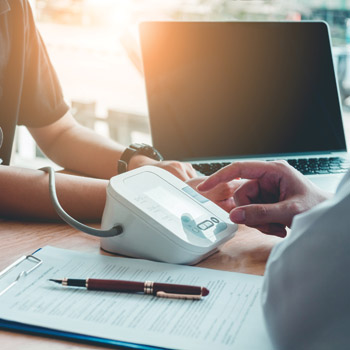ADHD more than a ‘condition of childhood’
Untreated adult patients with attention deficit/hyperactivity disorder (ADHD) have a higher rate of consequences that may result in underachievement. Proper detection can give internists a way to improve their patients' quality of life.
It was not that long ago when attention deficit/hyperactivity disorder (ADHD) was thought of as a condition of childhood that would “burn off” and resolve itself as patients grew up, said Jaesu Han, MD, clinical professor in the departments of psychiatry and family medicine at the University of California, Irvine.
But the consensus now is that about 60% of people diagnosed with ADHD as children will have symptoms into adulthood. The overall prevalence of the disorder in adults is 4.4%, and in adults older than age 50 years, it's 2.8% to 3.5%, said Dr. Han during his lecture “Psychiatry for the Nonpsychiatrist,” a module in ACP's CME 30 program.

“So we now know it's something that we really need to pay attention to because it goes on to have significant symptoms into adulthood,” he said. “The presentation, however, does change as these patients get older, so the hyperactivity symptoms, the impulsivity symptoms tend to become less prominent, or at least kind of moderate as one gets older, whereas the inattention symptoms remain largely unchanged.”
Under the DSM-5, introduced in 2014, patients with ADHD are required to have been diagnosed before age 12 years (DSM-4 cited age 6 years) and need to exhibit five symptoms as adults (as opposed to six in the DSM-4). DSM-5 also had adjustments in language to reflect more adult context in symptoms. For example, he said, inattention symptoms that predominate in adults exhibit themselves as poor time management and concentration, motivation, and distractibility.
“What that looks like in adults is that patients who are working will have difficulty finishing projects, returning calls, paying bills, keeping appointments with friends, as well as doctors' appointments, etc., and losing things like cell phones and keys,” he said.
Impulsivity in adults, meanwhile, often looks like very poor organization. “In fact, what you oftentimes hear is that these folks need other people to manage their lives to just make it work at all,” Dr. Han said.
Other behavioral issues involve a tendency to speak out of turn and to complete other people's sentences. The hyperactivity seen in children as a physical restlessness becomes in adults more of an inner restlessness, such getting up from their seats during meetings or being very fidgety or impatient.
Such symptoms have consequences, he said. Untreated adult ADHD patients have a higher rate of speeding tickets, traffic accidents, substance use disorders, incarceration, divorce, and domestic violence. “All of these things lead to lower education, underachievement, job loss, and lower household income, so real consequences of having attention deficit going into adulthood,” he said.
To diagnose ADHD in adulthood, physicians must sort through the very high prevalence of behavioral health comorbidity, Dr. Han noted. “We see a pretty high or increased prevalence of anxiety disorders, things like generalized anxiety disorder and PTSD [post-traumatic stress disorder] in particular, as well as mood disorders, and that's both bipolar disorder and major depression,” he said.
Patients can underreport symptoms, so the physician may require collateral information from others who know them well—a parent, a partner, a friend, or sometimes even a coworker—to provide context. “Even though oftentimes we worry about over-recording, it turns out that under-recording is a larger issue,” Dr. Han said.
There should be evidence of continuing symptoms over time, from childhood through adult life, in multiple settings, for example, at work, at home, and in relationships. “And in fact, if a patient only has symptoms in one sphere of their life, just home or just school, it actually suggests the symptoms are not attention deficit disorder, because it really is pervasive,” Dr. Han said.
The diagnosis also depends on a level of impairment. If patients say that they're frequently distracted, but there's no effect on job performance or consequences at home, then it raises the question of whether it has risen to the level of a disorder, Dr. Han said.
There are several tools available to screen for adult ADHD. The Adult ADHD Self-Report Rating Scale (ASRS), which Dr. Han said is used most frequently, was developed with the World Health Organization and has been recommended by European and Canadian guidelines. The ASRS-5 is a self-reported six-item questionnaire that is based on the DSM-5 and can be completed in less than five minutes, with very good sensitivity and specificity, Dr. Han said. A score of 14 or more is considered positive. If the patient screens positive on the ASRS, there is an 18-item ASRS v1.1 Symptom Checklist to track response to treatment.
Managing ADHD patients takes time, Dr. Han said. A physician must not only assess the patient's self-reported symptoms but also take time to assess for psychiatric or substance use comorbidities. Because comorbidity is so common, Dr. Han recommended treating that aspect first.
“So if a patient has, for example, substance use disorder, or they have severe anxiety, or in the midst of a major depression … rather than starting a stimulant first, you really want to get those other behavioral health conditions under control first,” he said. “And once those symptoms are better controlled, then considering managing the attention deficit disorder.”
Stimulants remain the gold standard in treating ADHD, both in children and adults. There are two main stimulants to consider, methylphenidate and amphetamine, and for adults, once-a-day preparations are preferred. “They're just more convenient as well as less abused and diverted compared to the immediate-release preparations,” Dr. Han said.
Side effects of stimulants include dry mouth, insomnia, irritability, decreased appetite and weight loss, headaches, and elevated blood pressure and heart rate. The FDA suggested in 2011 that stimulants should generally not be used in patients with serious heart conditions and that clinicians should periodically monitor for changes in heart rate and blood pressure, but they are not contraindicated in adults, Dr. Han said.
Body mass index should be tracked in patients taking stimulants, and vital signs, including blood pressure and heart rate, should be assessed every six months, Dr. Han advised. There is no need for routine blood tests or electrocardiograms. Since stimulants are a Schedule II drug, consider a treatment agreement that outlines no early fills, single-clinician prescribing, and random urine drug screens, as for an opioid, he said.
There is an alternative therapeutic option, atomoxetine, which is FDA approved for ADHD in adults but has a smaller effect size compared to the stimulants, Dr. Han said. However, if a patient has significant substance use disorder history or can't tolerate a stimulant, atomoxetine is a reasonable medication to use. Physicians should be aware that there is a delay of several weeks before symptomatic improvement with this drug, in contrast to the stimulants, which work immediately, Dr. Han said.





